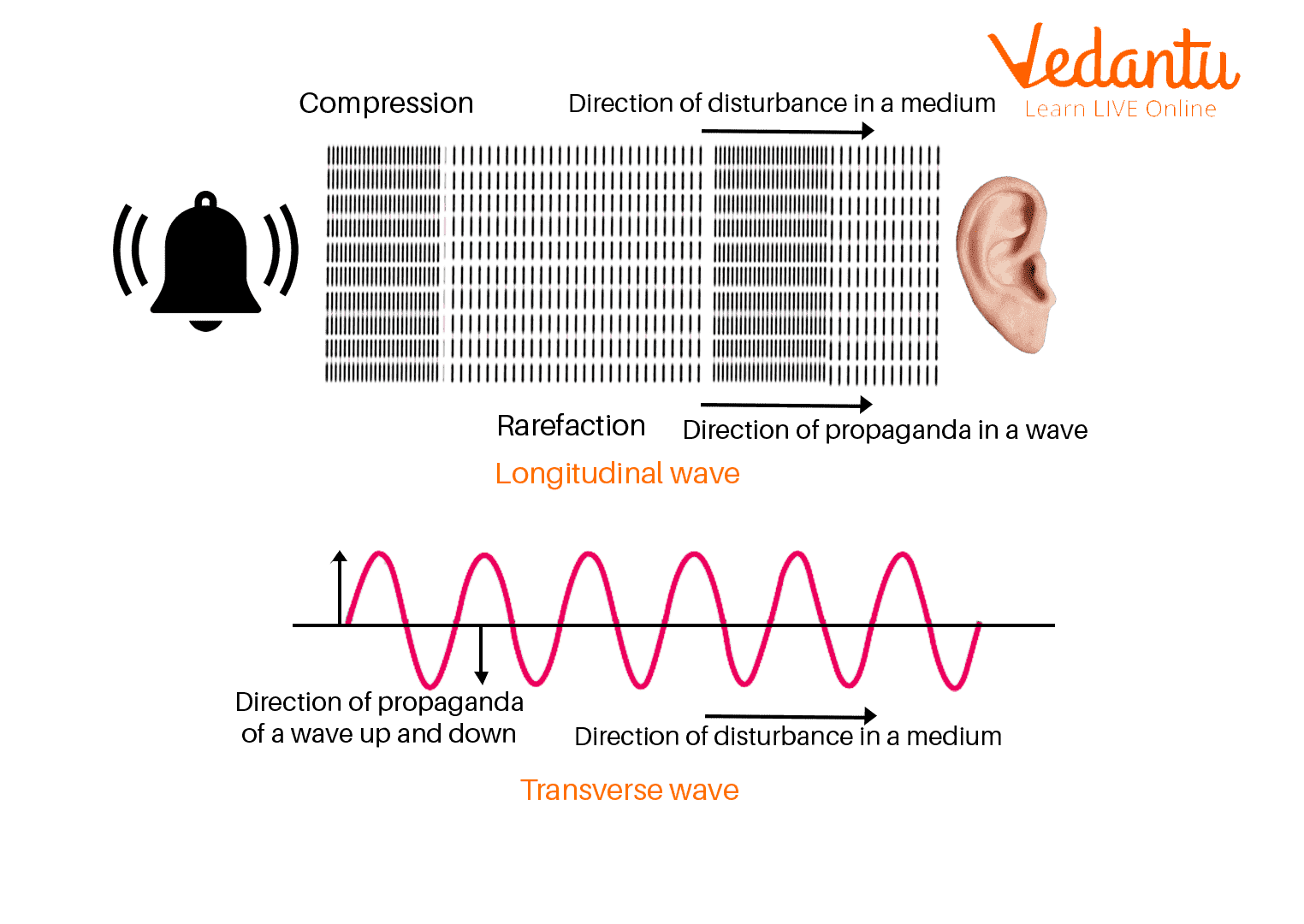




Understanding Sound Propagation: Mechanism and Examples
We hear a variety of sounds around us in our daily life. We hear some sounds around us that are soft, some sounds are very loud, some sounds are shrill, and some sounds appear pleasant to us. If someone knocks at the door from the outside, the person inside the room can hear it. This is an example of the propagation of sound.
With the help of science of sound, Biologists can figure out how animals like elephants can communicate over long distances. Geologists use sound waves to detect geologic features under the surface of the earth. Bats and dolphins use sound waves to navigate their way around.
Sound Waves and Its Condition for Propagation
Sound is a form of energy that produces a sensation of hearing in our ears and this sensation which is felt by our ears is called sound. Sound needs a medium to travel. Sound can travel fastest in solids. So, we can say that solid is the best medium of sound.
Sound waves are longitudinal waves. Waves in which particles of the medium move in a direction parallel or antiparallel to the direction of energy transport are called longitudinal waves. We will understand this by the figure given below. From the above figure, we can see that the particles of the medium are vibrating in the direction of the propagation of waves. 
Propagation of Sound Waves
Propagation of Sound
When the vibrating object moves forward, it pushes and compresses the air in front of it, which creates a region of high pressure. This region is called a compression. Compressions are the regions where the density as well as pressure are high. These compressions start to move away from the vibrating object. When the vibrating object moves backwards, this vibrating object creates a region of low pressure which is called rarefaction. Rarefactions are the regions where the density as well as the pressure is low. As the object moves back and forth rapidly, it creates a series of compressions and rarefactions. This series of compressions and rarefactions makes the sound wave which propagates through the medium. The regions of compressions and rarefactions are shown in the above figure.
Sound waves are also called pressure waves because the sound wave consists of the repeating pattern of high pressure regions called compressions and low pressure regions called rarefactions.
Important Properties of Sound
Here are some important properties of sound:
Wavelength: The distance between two consecutive compressions or two consecutive rarefactions is called the wavelength of sound.

Wavelength of Sound Waves in Terms of Compression and Rarefaction
This figure is shown here to understand the definition of the wavelength of sound in terms of compression and rarefaction. Wavelength of sound is generally represented by the Greek letter $\lambda $
Its SI unit is metre (m).
Frequency: Suppose you are beating a drum. The number of times you beat the drum per unit time is called the frequency of the drum. If we beat the drum 10 times in 1 min, then we can say that its frequency is 10beats/min.
So, we can say that frequency is the number of compressions or rarefactions that crosses a particular region per unit time. It is denoted by the symbol f and its SI unit is hertz (Hz).
1 hertz is defined as 1 oscillation or 1 cycle per second.
Time Period: The time taken by the two consecutive compressions or rarefactions to cross a fixed point is known as the time period of the sound wave and it is denoted by the symbol T.
Time Period $T = \dfrac{1}{f}$, where $f$ is frequency
Its SI unit is second (s).
Amplitude: It is defined as the magnitude of the maximum displacement of each particle from its mean position. It is represented by the letter A. Its SI unit is metre. It depends on the force with which the object is made to vibrate. The amplitude of the sound wave determines the loudness or softness of sound. The sound with greater amplitude is louder.
Solved Examples
A sound wave has a frequency of $40\,Hz$ and wavelength of $9\,m$. Calculate its speed.
Ans: Given, Frequency of a sound wave is $f = 40\,Hz$
Wavelength is $\lambda = 9m$
Here, we will use the relation $v = f \times \lambda $
So, $v = (40)(9) = 360\,\dfrac{m}{s}$
So, its speed is $360\,\dfrac{m}{s}$
A piece of paper completes 50 vibrations in $5\sec $, when some waves pass through the surface of water. Calculate the time period and the frequency of the piece of paper. If the wavelength of the wave is $20\,cm$, then find the velocity of the waves.
Ans: Given, Vibrations $n = 50$
Time taken is $t = 5s$
Wavelength is $\lambda = 20\,cm$
We know that frequency is the number of waves passing per unit time. So, to calculate frequency, we will use the relation $f = \dfrac{\text{vibrations}}{\text{time}}$
$ \Rightarrow f = \dfrac{{50}}{5} = 10\,Hz$
Hence, the frequency of the piece of paper is $10\,Hz$
For time period: $T = \dfrac{1}{f}$
$\therefore, T = \dfrac{1}{{10}} = 0.1\sec $
So, the time period of the piece of paper would be $0.1\sec $.
Now, we have to calculate the velocity of the waves, we will use the relation $v = f\lambda $
$\therefore, v = (10)(20) = 200\dfrac{{cm}}{s}$
So, the velocity of the waves would be $200\dfrac{{cm}}{s}$.
Interesting Facts
The loudness of sound is generally measured in “decibels” and greater than 85 decibels can damage our hearing.
Doctors use sound waves to identify the health of a person’s heart.
Sound can travel faster in water than in air.
Conclusion
From the above discussion, we can conclude that sound is produced by vibrations. Without vibrations, sound cannot be produced. To and fro motion of an object is called vibration which occurs at a high frequency. Each sound has its own wave and each wave has certain properties that make the sounds around us different from each other. These are frequency, amplitude, and wavelength. We can also say that medium is necessary for the propagation of sound.
FAQs on Why Sound Needs a Medium to Travel
1. What does it mean that sound needs a medium for propagation?
This means that sound, which is a form of energy created by vibrations, cannot travel through empty space. It requires a substance, known as a medium, to carry these vibrations from the source to a listener. This medium can be a solid, a liquid, or a gas. The particles of the medium vibrate and pass the energy along, allowing the sound to be heard.
2. How can an experiment demonstrate that sound requires a medium to travel?
The classic bell jar experiment is a perfect demonstration. The steps are as follows:
- An electric bell is placed inside an airtight glass bell jar and is switched on. The sound is clearly audible.
- A vacuum pump is connected to the jar and starts removing the air from inside.
- As the air is gradually pumped out, the sound of the bell becomes fainter and fainter, even though you can still see the hammer striking the gong.
- When a near-vacuum is created inside the jar, the sound can no longer be heard.
3. Why does sound travel fastest in solids, followed by liquids, and slowest in gases?
The speed of sound is determined by how closely the particles of a medium are packed and how quickly they can transfer vibrations.
- In solids, particles are very tightly packed. This proximity allows vibrations to be transferred extremely rapidly from one particle to the next, making solids the fastest medium for sound.
- In liquids, particles are close but can move past each other. The transfer of vibrations is efficient but slower than in solids.
- In gases, particles are far apart. It takes longer for a vibrating particle to collide with and transfer energy to its neighbour, making gases the slowest medium for sound propagation.
4. If sound needs a medium, do the particles of the medium travel from the source to our ears?
No, the particles of the medium do not travel the entire distance. This is a common misconception. The particles of the medium only vibrate back and forth around their fixed equilibrium positions. They bump into adjacent particles, transferring the sound energy, which creates a wave of high-pressure regions (compressions) and low-pressure regions (rarefactions). It is this energy wave that propagates through the medium, not the particles themselves.
5. Why can't we hear explosions or any other sounds in the vacuum of space?
Space is essentially a vacuum, meaning it is almost completely empty of matter and lacks a medium. Sound waves are mechanical waves, which means they must have a substance (like air, water, or metal) to travel through. Without any particles to vibrate and carry the sound energy, the waves cannot propagate. Therefore, any event in space, no matter how loud, would be completely silent to an observer there.
6. How is the propagation of sound different from the propagation of light?
The main difference lies in their requirement for a medium.
- Sound waves are mechanical waves. They require a physical medium (solid, liquid, or gas) to transfer energy and cannot travel through a vacuum.
- Light waves are electromagnetic waves. They do not require any medium for propagation and can travel perfectly through the vacuum of space. This is why we can see the sun, which is millions of kilometres away, but we cannot hear it.
























